 When it comes to breakfast, most of us have a place in our hearts for certain cereals. Even for those who felt they were the kid whose parents forced them to eat “healthy cereal,” surely some of the mainstream sugary stuff also managed to make a mark. If asked to name five childhood cereals, most adults could do it as easily as naming five colors. Adults who were children in the 80s, 90s, 00s, however may likely name some cereals today’s generation will never hear of. Starting in the late 70s, companies began to market pop culture theme-cereals to kids. Seriously, even C-3PO and Steve Urkel once had cereals based off them. The tradition of theme-cereals has been homogenized today, but not homogenization
When it comes to breakfast, most of us have a place in our hearts for certain cereals. Even for those who felt they were the kid whose parents forced them to eat “healthy cereal,” surely some of the mainstream sugary stuff also managed to make a mark. If asked to name five childhood cereals, most adults could do it as easily as naming five colors. Adults who were children in the 80s, 90s, 00s, however may likely name some cereals today’s generation will never hear of. Starting in the late 70s, companies began to market pop culture theme-cereals to kids. Seriously, even C-3PO and Steve Urkel once had cereals based off them. The tradition of theme-cereals has been homogenized today, but not homogenization  like the term is commonly used with milk. Theme-cereals are far less common, almost near extinct. So what killed variety in those fortified-with-vitamins, getting soggy so you better eat ‘em fast, beloved breakfast cereals?
like the term is commonly used with milk. Theme-cereals are far less common, almost near extinct. So what killed variety in those fortified-with-vitamins, getting soggy so you better eat ‘em fast, beloved breakfast cereals?
To answer this, we need to dig into the past just a bit.
Hot cereals and porridge had been breakfast staples for thousands of years. In the late 19th century, some American chefs/inventors started tinkering with convenient cold cereals. America loved packaged breakfasts and there was a “gold rush” for selling cold cereal in the early 20th century. For nearly fifty years, simple grain-based cereals were enough. Then in the 1950s, as the country grew more interconnected in infrastructure: roads, phone lines, news, and some of the cereal manufacturers started to realize they had a niche demographic for marketing—kids.
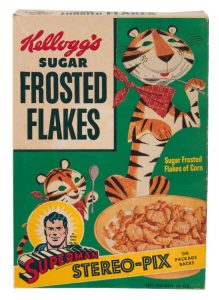 What appealed to kids in cereal? Sugar, basically. Frosted Flakes was introduced in 1952. Of course, the biggest change in the country’s inter-connection was just beginning to spread. Television allowed for a perfect medium to appeal to kids using cartoon mascots for cereal. By the 60s, all the major players were there: Tony the Tiger, Cap’n Crunch, the Lucky Charms Leprechaun. The roster continued to grow through the decade, and whole teams seemed to form, like Count Chocula and his frightful breakfast buddies. The diversity of mascots stemmed from many manufacturers vying for as much of children’s attention and appetite as they could get. In the 70s, some of these companies began to seek mascots who were already established in the kid world. For example, Winnie the Pooh got a cereal—thankfully they didn’t call them Pooh Puffs. The most successful marriage of mascot and cereal came when Fruity and Cocoa Pebbles used the popular Flintstone’s characters.
What appealed to kids in cereal? Sugar, basically. Frosted Flakes was introduced in 1952. Of course, the biggest change in the country’s inter-connection was just beginning to spread. Television allowed for a perfect medium to appeal to kids using cartoon mascots for cereal. By the 60s, all the major players were there: Tony the Tiger, Cap’n Crunch, the Lucky Charms Leprechaun. The roster continued to grow through the decade, and whole teams seemed to form, like Count Chocula and his frightful breakfast buddies. The diversity of mascots stemmed from many manufacturers vying for as much of children’s attention and appetite as they could get. In the 70s, some of these companies began to seek mascots who were already established in the kid world. For example, Winnie the Pooh got a cereal—thankfully they didn’t call them Pooh Puffs. The most successful marriage of mascot and cereal came when Fruity and Cocoa Pebbles used the popular Flintstone’s characters.
Even though the Flintstone’s helped sell cereal, the evolution of marketing cereal to kids took a slight break in the later 70s. Was using cartoons to sell sugary, and arguably unhealthy cereal, a bit shady? Was appealing to a kid’s fondness for cartoons and forcing parents to walk down the cereal aisle as their kids were subliminally sold to, perhaps a little unethical? The Federal Trade Commission thought so. Although these things were of concern in the Carter-era, they were dismissed in the Reagan-era. Yes in fact, Reagan policies saw marketing to children as a fair concept. The common deregulation of government in the 80s brought drastic changes to the cereal world. Namely, manufacturers began to seek icons from the entertainment world to again help sell cereal.

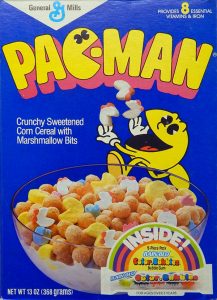 Popular cartoons of the era like Smurfs and Strawberry Shortcake, quickly became cereal. Options weren’t limited to cartoon characters though. Pac-Man and Donkey Kong each got a cereal, as did E.T., and speaking of T’s, you best pity the fool who never got to eat Mr. T. cereal. One thing about these early cereals that was different than those to come later, most weren’t meant to be limited runs. Surely Pac-Man would be a cutting edge game for decades to come., right? Well, Pac-Man fever of the 80s eventually wore off, as did popularity of other themes. So manufacturers soon began to make limited runs on theme-cereals. Basically, theme-cereal became fad-cereal. A rotating door of cereals meant things like GI Joe,
Popular cartoons of the era like Smurfs and Strawberry Shortcake, quickly became cereal. Options weren’t limited to cartoon characters though. Pac-Man and Donkey Kong each got a cereal, as did E.T., and speaking of T’s, you best pity the fool who never got to eat Mr. T. cereal. One thing about these early cereals that was different than those to come later, most weren’t meant to be limited runs. Surely Pac-Man would be a cutting edge game for decades to come., right? Well, Pac-Man fever of the 80s eventually wore off, as did popularity of other themes. So manufacturers soon began to make limited runs on theme-cereals. Basically, theme-cereal became fad-cereal. A rotating door of cereals meant things like GI Joe, 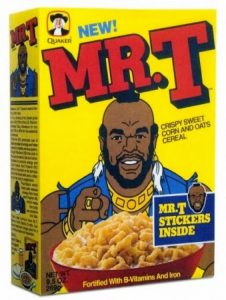 Transformers, Cabbage Patch, Ghostbusters, Gremlins, and way too many cereals to mention here, all got representation. Pretty much, if something was popular enough, it was likely to end up on the cereal aisle. Getting “cerealized” became a right of passage. Some cereals hung around for a while, like the Nintendo Cereal System, or Ninja Turtles ‘
Transformers, Cabbage Patch, Ghostbusters, Gremlins, and way too many cereals to mention here, all got representation. Pretty much, if something was popular enough, it was likely to end up on the cereal aisle. Getting “cerealized” became a right of passage. Some cereals hung around for a while, like the Nintendo Cereal System, or Ninja Turtles ‘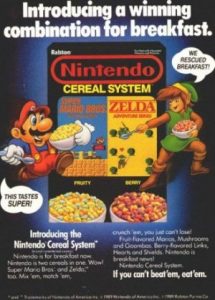 Lucky Charm’ clone. Through the 90s, themes continued to come and go based on popular things like Barbie, the Spider-Man cartoon, and even a New Kids on the Block cereal.
Lucky Charm’ clone. Through the 90s, themes continued to come and go based on popular things like Barbie, the Spider-Man cartoon, and even a New Kids on the Block cereal.
1994 marked a sad year for the loss of variety in the realm of theme-cereals. In this year, the Ralston cereal company was acquired by General Mills. Ralston had been started in 1902, and it was responsible for a large share of theme-cereals in the 80s. This event was a precursor of things to come. Acquisition of small and large food companies became fairly common practice in the 2000s. Breakfast cereal was no exception. Pepsico took over Quaker in 2001. Kraft took much of Nabisco’s cereal line in 2000. Post got Malt O’Meal in 2015.
To homogenize is essentially, to make similar, to thus lose differences. Fewer companies meant less competition. Cereal manufacturers didn’t need to spend as much money on gimmicks and paying royalties to popular trends in order to attract children. Theme-cereals began thinning out in the early 2000s, with less and less theme-cereals after 2010. There have been exceptions, with some pop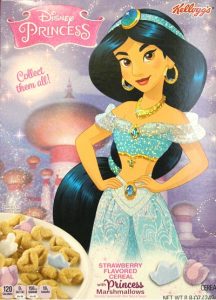 ular fads still managing to transition to cereal. Another part of homogenization is that children’s entertainment is no stranger to acquisitions by larger companies either, and larger companies have more leverage to make deals with cereal producers, or to exclude others out. Most theme-cereals of the past few years stem from one major source. Can you guess…it’s Disney.
ular fads still managing to transition to cereal. Another part of homogenization is that children’s entertainment is no stranger to acquisitions by larger companies either, and larger companies have more leverage to make deals with cereal producers, or to exclude others out. Most theme-cereals of the past few years stem from one major source. Can you guess…it’s Disney.
In the 80s and 90s, it was common to sometimes see up to ten-active cereal themes. Recent years have seen as little as one or two theme-cereals, per year. The trend doesn’t suggest the future will see much more variety, and for those of us who grew up with these themes, it probably seems like a huge loss. Of course, most of the theme-cereals simply copied a recipe from another cereal. Theme-cereals were essentially marketing gimmicks. Yet, theme-cereals allowed kids a more immersive experience into some of their favorite things. Kids got to feel like something was special about those breakfasts, and it was. Theme-cereals helped to capture a time and place where something popular was geared just toward them, not something their parents or even older siblings may have eaten. This is why most those bygone cereals stick out so strong in people’s memories. They felt so special at the time. The loss of themes surely won’t warp children of today, but perhaps in the future, they’ll unfortunately remember their breakfasts as a little less flavorful than those of us who can close our eyes, hear the milk splashing, and remember the taste of cereals that tasted better simply because they were based off something we might have momentarily loved.
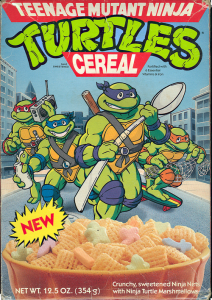
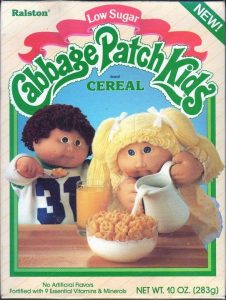
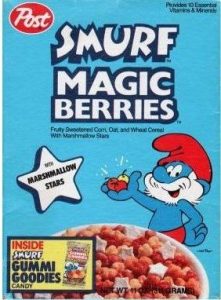
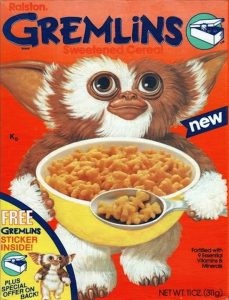
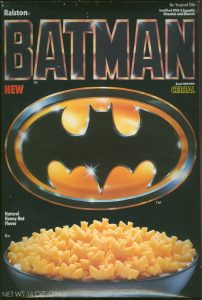
One Reply to “M.Y.O.P.I.A. #19: Homogenization—A Cereal Killer”
Comments are closed.